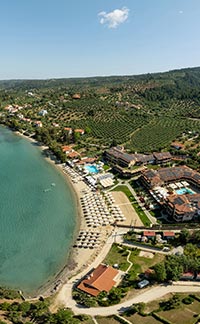Halkidiki is the northern Greek three-fingered (Greeks call them “legs”) peninsula growing out of a larger peninsula jutting south into the Aegean Sea, rather like a hand missing its thumb and pinkie. With more than 500km of coastline, it is easily the most popular holiday destination in Northern Greece, and a special favorite of locals from Thessaloniki, about 100 km to the west.
The name “Halkidiki” is derived from Halkida, a city-state (and modern municipality) north of Athens which founded colonies on the peninsula starting around 800 BC.
The ancients called it “Flegra” - “Place of Fire”, because it was the ground of a great battle between the gods of Olympus and the Giants, who were the sons of Gaia, the Earth. The mythology of Halkidiki is closely related to its geomorphology. The Giants were trying to depose the Olympians from Mt. Olympus. One of the Giants, Enceladus, was crushed by a rock under Kassandra, the westernmost peninsula. Buried under the rock, even now he still struggles to break free from time to time, which explains the region’s periodic earthquakes.
Another myth states that the peninsulas were created by Poseidon’s trident, thrown into the earth in anger because two giants were fighting over the beautiful mermaid, Pallini (Pallini was the name of Kassandra peninsula before it was re-named in the 4th century, BC, after Kassandros, king of Macedonia and one of Alexander the Great’s heirs. Sithonia, the middle peninsula, was the name of one of the giants, as was Athos, which is now home to the Holy Mountain with its 20 Orthodox monasteries.
Halkidiki is its own prefecture, or regional unit, its capital at Polygyros, built in the foothills of Mt. Holomonta at an elevation of 1,165m, Halkidiki’s 2nd highest point after Mt. Athos (2,033m). It is a multi-faceted region which always keeps the eye entertained, featuring pristine beaches, pine forests, strangely-shaped boulders (which gave rise to the myth of the battle of the Giants), beautiful seas, fertile fields, and abundant olive orchards.
Halkidiki is one of the most popular tourist destinations in Europe, with its well-appointed seaside resorts, its traditional mountain villages, its rich palette of natural colors, especially during sunrises and sunsets, all under the magnificent azure sky of Greece. It’s beaches, collectively, are awarded the greatest number of Blue Flags, given for cleanliness and amenities, of any region in Europe.
Best hotels in Halkidiki
Situated 2.5 km north of the famous ancient canal of Potidea, and just 40 minutes from Thessaloniki, Portes Lithos has everything you need for an affordable, luxury getaway
Set amongst the olive groves of the eastern shore of Kassandra, the westerly most of the three fingers, Aegean Melathron offers 5-star service for some of the best prices in the region
Anthemus Sea Beach can be found about halfway down the Sithonia peninsula, the middle peninsula of Halkidiki, on 38,000 m2 of west-facing Blue Flag beachfront property known as Elia Beach
Boat owners have no lack of moorage in places like the marinas at Porto Carras (Sithonia) and Sani (Kassandra). There are dozens of picturesque moorages all over the three peninsulas.
Every kind of water sport imaginable is available to you, from scuba lessons and rentals, jet skis, canoes and bicycle rentals, windsurfing, balloon flights, and a great 18-hole golf course at Porto Carras. You can rock climb, mountain bike and do some off the road adventuring.
There are protected nature preserves, opportunities to take day cruises to secluded corners of the peninsulas and offshore islands, and lagoons and lakes waiting for you to explore. There are geothermal springs in places like Loutra of Agia Paraskevi, known for their healing properties. And there are many important archeological sites at Olynthos, Stagira (Aristotle’s birthplace), Potidaea, Toroni and the world-famous Petralona Cave, where the remains of the most ancient human in Europe have been found.
Halkidiki is home to world-class agricultural and food products such as its local olives, olive oils, wine, honey, and seafood, providing a rich gastronomic element to your visit. These products can be enjoyed in local tavernas and restaurants.
All of which makes this magical region one of the favorite Greek tourism destinations for youth and family or for a romantic getaway.
Halkidiki is considered an ideal place for living and recreation, long-term and short-term, offering relaxation and repose, with all the comforts of European-standards resort and the municipal infrastructure, and an excellent local bus network which connects you with all of the Halkidiki resorts, as well as with Thessaloniki. Its proximity to Thessaloniki provides easy access to the Macedonia International Airport, with its direct flights to cities in Europe and Russia.
While staying at Peninsula, you can make day trips to Thessaloniki, Pieria (Litochoro, Dion, Mt. Olympus), Aridi, Veria, Kastoria and Kalambaka (Meteora), and take ferries to Ammouliani and Ouranoupolis (at the threshold of Mt. Athos).
From Nea Moudania, Pefkohori and Neos Marmaras you can catch a "flying dolphin" to islands such as Skiathos, Skopelos and Alonnisos, in the Sporades, or take cruises in smaller boats all around the peninsulas of Halkidiki, including Mt. Athos.
Halkidiki, in short, offers all the elements for an exciting, interesting, educational, and relaxing holiday.















